The Content Marketer’s Workflow: 6 Steps to Get Your Content Visible Online
You already create great content, you just need your customers to see it. This content strategy workflow can help deliver 10x more value and drive traffic.
It takes time to create great content: you brainstorm, research, design and redesign, brand, edit, and optimize. After a brief flurry of traffic from your distribution channels, there’s a problem: your content goes quiet. As soon as you stop actively promoting it, people stop finding it.
30 Minutes on the Last 30 Days In Search & Content
It's exhausting and the results are erratic when you depend on short spikes of traffic to drive your content strategy. On the other hand, if you have just one piece of content that ranks well in organic search, over time it delivers 10x more value than the rest of your content marketingContent Marketing
Content marketing is a marketing discipline with the goal of increasing awareness and scope for products and brands in the desired target group with content published on the web and offline.
Learn more plan combined.
You already create great content, you just need your customers to see it. This workflow can help:
6-Step Content Strategy Workflow
- Research topics: Identify the trends and topics that are in demand.
- Analyze type: Know what content format will resonate best.
- Map content: Target buyer personas along the customer journey.
- Optimize: Improve the content you have to maximize ROI.
- Configure site: Segment, compare, and measure your content.
- Report: Create reports to share your success.
Step 1: Identify the trends and topics that your customers are searching for so you create content that’s in demand
Come up with an initial list of topics with your team, and then use a keyword research tool to decide which topics will resonate best with your audience. Look at:
- Search volume – Find high search volume terms that are relevant to your topics. Select a cluster of related terms for each individual topic.
- Search intent – Determine whether searchers are looking for early (educational), mid (exploring solutions), or late stage (transactional) content along the customer journey.
- Competition – High page authority results in the top positions and stagnant results (they don’t change much week to week) indicate difficulty.
Which keyword would you choose—term A with 10,000 MSV or term B with 1,000 MSV? Term A, right? Not so fast!
A Keyword Research Tool can help you think in terms of clusters: you might find there are 100 related terms for B and only 5 related terms for A. So the math means the potential reach for A: 10x5=50,000 MSV. The potential reach for B: 1x100=100,000 MSV) If you are looking for volume, B is the better choice.
Content Strategy Spotlight: JanSport
We used to call one of our products a “digital bag” in our content. Our keyword research showed us that consumers didn’t know what a “digital bag” was or think about our products that way.
The fact is: you can have an amazing product that people love, but if no one can find it online, you won’t drive interest or traffic.
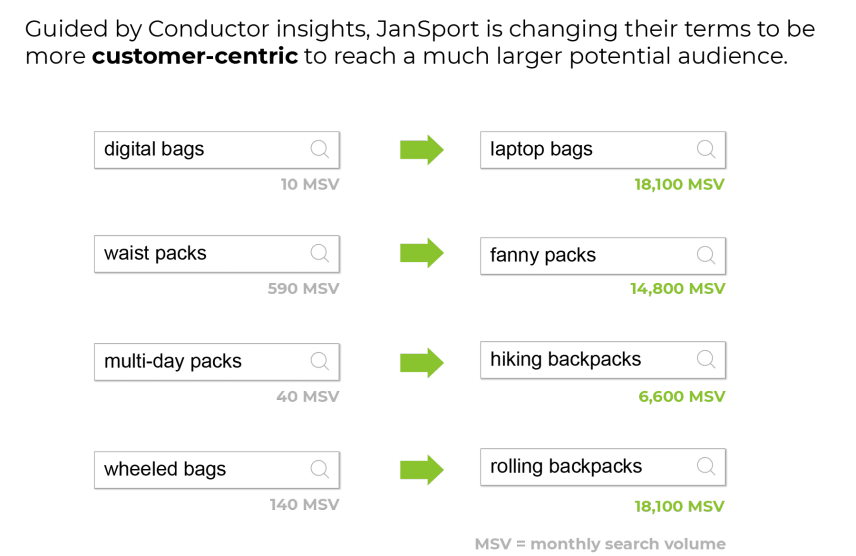
Step 2: Know what type of content -- like videos, articles, or images – will resonate most with your audience
Now that you have your topics, decide what format your content should take. Search for the terms you found in step one, and look at the content formats that appear on the search engineSearch Engine
A search engine is a website through which users can search internet content.
Learn more results pages (SERPS) for your topics. You’ll see formats like:
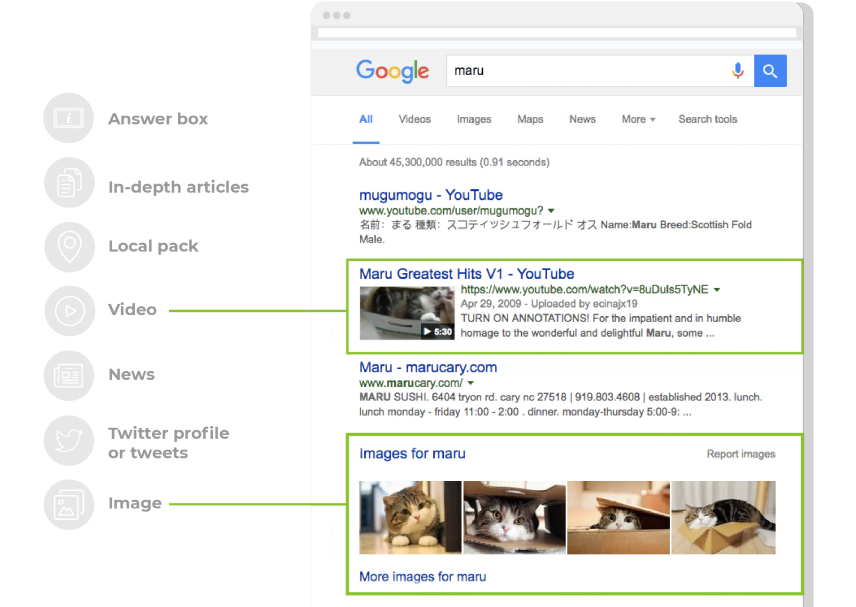
Manually search, or use your content and SEO platform to see how those formats vary across search locations and devices.
Go ahead and click through on the top ranking results to get a better understanding of your competitors’ content and page structure. (Model your content after the top rankers but do it better.)
Content Strategy Spotlight: Birchbox
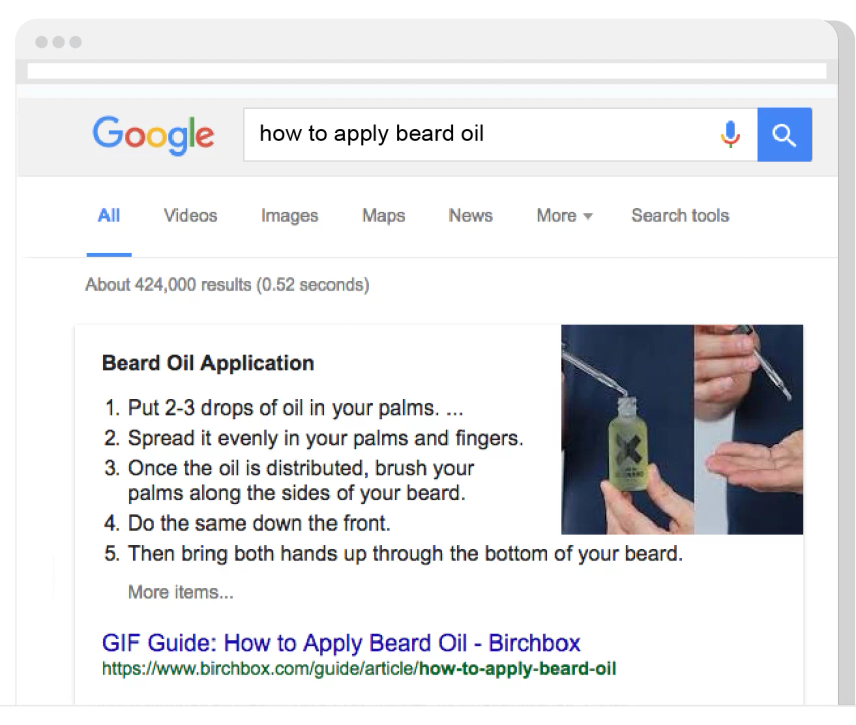
“Our Beauty Essentials series takes a simple, educational approach, teaching basic beauty skills. The products are secondary. The topics are SEO-friendly, so organic search has been a huge driver. It consistently gets great engagement and great sentiment.”
Step 3: Create the right content for the right customer at the right stage of the customer journey
It’s time to think about how the content you’re creating will fit into your overall content strategy. Content mapping will help you accomplish two things:
- Complement the assets you have. Fill gaps instead of creating redundant content.
- Get qualified traffic, not just any traffic. Map your content to the right customer when they’re looking for it.
Categorize your content by buyer’s persona and customer journey stage. Tackle your whole site or just take on a section, campaign, or product. If you don’t have content mapping technology, use an excel sheet to track your urls.
When you have created a content map, you’ll be able to see cracks in your content strategy. Look for opportunities to create content where you’re not visible, or optimize content that’s visible but not converting.
Content Strategy Spotlight: Sealed Air

“As the world gets more sophisticated, we need to produce the right content for the right person at the right time. And Searchlight’s Content Mapping feature allows us to map out our buyer personas and journeys. With it, we see content and keyword gaps.”
Step 4: Optimize the content you have to maximize ROI
As content marketers, we can get swept up in the frenzy of creating new content and rarely revisit what’s already on our site. But improving the assets you have is critical – you can get big payoffs for a small amount of work.
You have access to change a few things in your source code, like title tags, meta descriptionMeta Description
The meta description is one of a web page’s meta tags. With this meta information, webmasters can briefly sketch out the content and quality of a web page.
Learn more, H1 tags, and body content.
Titles and Meta Descriptions help convey to Google what your page is about, and also help entice searchers (who see your result snippet) to click on you.
Add keywords and details to your calls-to-action (“Red Cars” vs “Red Convertible Cars”) or Meta Descriptions (“We have the best red cars.” vs “We have the best red cars and have $0 APR for 24 months”)
You can also optimize your image titles, alt tags, url, and body copy with keywords.
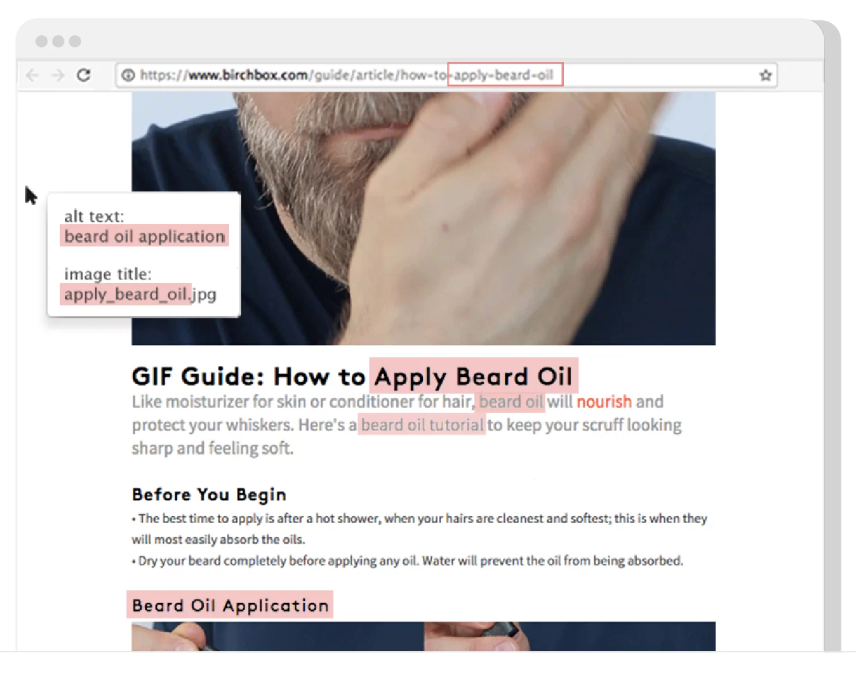
Ultimately, optimizations are an experiment. There’s no one right way. Here are some experiments you may want to try to increase your conversions and rankingsRankings
Rankings in SEO refers to a website’s position in the search engine results page.
Learn more:
- Freshen and improve the quality of that content to better fit buyer personas and customer journey stage (look at user intent)
- Break up large pieces of content into focused, small pieces
- Combine small pieces into a larger piece, redirecting existing posts to strengthen the authority of a single page
- Improve your internal linking structure to add authority – have high-authority pages point links to the page you want to rank
- Implement A/B testing and change up page elements like colors, fonts, images, and CTAs to see what converts best
- Conduct social and link campaigns to get external signals to bolster the authority of existing pages
As you make changes, keep a record of what changes you’ve made for each page, and when (the easiest way to do this is to add and automate annotations in your content software).
Content Strategy Spotlight: Republic Wireless
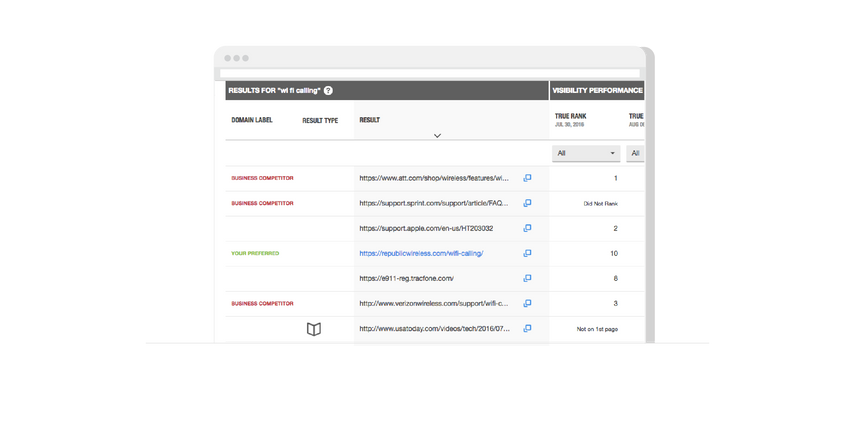
I wanted to optimize our wifi calling page, which is an extremely high competition search term. I expanded our page with related keywords and optimized the metadata. After we focused on optimizing that page, we’ve seen 108% more traffic, 100% more revenue, and 22% longer session duration.
Step 5: Segment, compare, and measure your content to see how well you’re performing
Configure your tracking technology (analytics or SEO platform) so you can quickly understand your content wins and losses.
Set up segments, groupings of pages, on meaningful parts of your business. Segment examples:
- Product category (bedding pages, bathroom pages, etc.)
- Sections of your site (company blog, learn center, product pages, free trial page, etc.)
- Author (journalist A, freelancer B, employee C)
Set up categories, groupings of keywords, so you can see when you are visible for topics important to your strategy. Categories Examples:
- Branded and non-branded (“Ikea lamp” vs. “best lamp for dorm room”)
- Topics (Manufacturing, Packaging Solutions, Hygiene Products)
Content Strategy Spotlight: Madison Reed
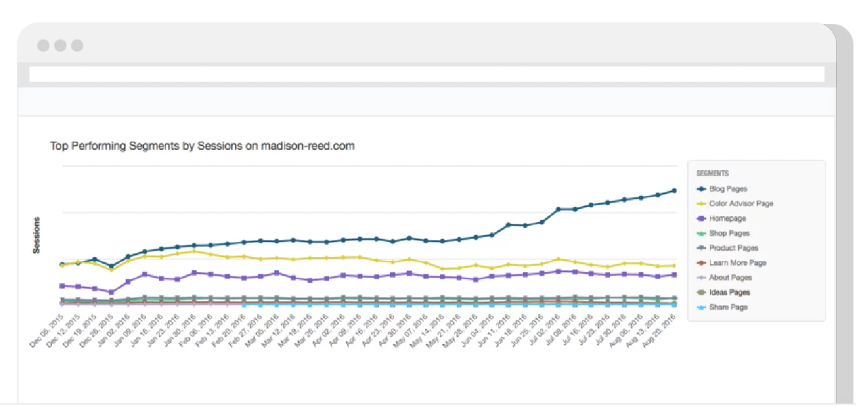
Setting up page segments and categories is time well spent. They highlight the problems and the victories we’re achieving with our content strategy. Every Monday, I look for big drops and gains in our segments and categories. I use that information to plan out high-impact activities like content creation and optimization.
Step 6: Create reports to share your success
Reports do two important things. They enable you to continuously improve your strategy and to communicate the impact you’ve had on your business to other parts of your organization. Reports can help you get more resources by showing the potential money and market share that’s on the table.
Think of reports in terms of questions you want to answer for your site:
- Are we succeeding in creating or improving content that is visible for target keywords?
- Are we hitting our targets for rank positions and traffic for those pages?
- How is a particular new piece of content doing? Is it bringing in new organic traffic? How is it ranking for the keywords we are tracking?
- Which of our writers brings in the most organic traffic? (Create segments based on writers to see these trends.)
- What are our top 10 highest visited pages by organic, and overall?
- Which keywords do our competitors rank for where we don’t?
- How does our overall organic market share compare to our competitors?
- Have we gained or dropped visibility or conversions for important pieces of content? (Pay special attention to movement to or from the first page of search engine, where the vast majority of clicks occur.)
- If we had more resources to target more content opportunities, what ROI could we achieve?
Content Strategy Spotlight: Seer
Our workspaces (reports) cover a range of target areas for our clients, like search competition, content strategy analysis, and keyword research. They help inform decisions, create content for clients, encourage quicker arch updates and give us an idea of the competitive landscape.
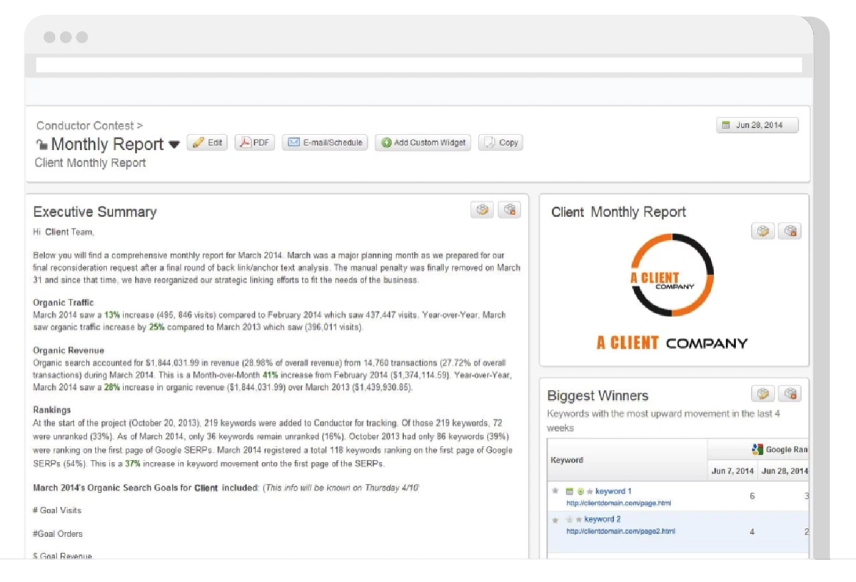
The Content Strategy Workflow Golden Rule: Know What's in Demand
If you take nothing else from this workflow, remember this: you will be more successful if you assess customer demand before you create content.
Second, don’t focus solely on creation. Spend time improving content you have – you’ll ultimately drive more value if you are resourceful with the content that’s already available to you.
Finally, carefully configure and measure your site, making sure you can understand the value of your work, and share it with others.
What's your content marketing plan for organic search? How do you get your content visible online?
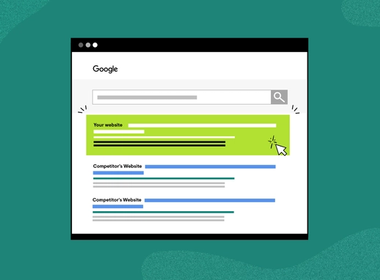
![Victoria Reuter, [object Object]](https://cdn.sanity.io/images/tkl0o0xu/production/bb210b598c47326b4a50dcb9c2f76bdbf14024c2-580x580.png?fit=min&w=100&h=100&dpr=1&q=95)

![Ben Pollack, Director, Global Demand Generation & Digital Marketing, [object Object]](https://cdn.sanity.io/images/tkl0o0xu/production/4ff3a5fd8a4af8b6c1bea864e077578483205247-1765x1765.png?fit=min&w=100&h=100&dpr=1&q=95)
![Cody Gault, Migration Services Lead, [object Object]](https://cdn.sanity.io/images/tkl0o0xu/production/deba62b44932c3f4231f9dfad1354b45547c00d0-1771x1771.png?fit=min&w=100&h=100&dpr=1&q=95)
![Wil Reynolds, VP Innovation, [object Object]](https://cdn.sanity.io/images/tkl0o0xu/production/978e56af78dde0d22e5389f92616bb25ce6fdcd8-800x800.png?fit=min&w=100&h=100&dpr=1&q=95)






